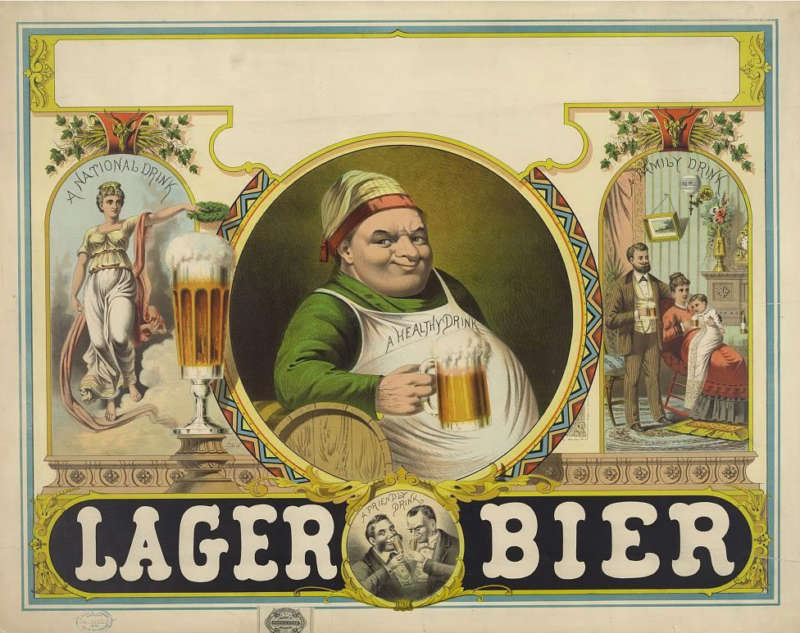
for the future selling of steins on auction sites such as eBay, etc. My web site was really started as an informational site for beginning beer stein collectors that would be looking for the info and not the general public. This
STILL =
(The) Plague, (Black Death) – No plague or “Black Death” was responsible for causing beer steins to have lids, regardless of what you have heard or read elsewhere!
SEE: “Why the lids on beer steins? [1] The real reasons!” = http://www.steveonsteins.com/why-the-lids-real-reason.
and PLEASE view: http://www.steincollectors.org/ — go to “READING ROOM (LIBRARY)”, click on “Added Oct 2011: “Why Steins have Lids – An interesting video presentation” = A super job by a friend in No. Carolina.
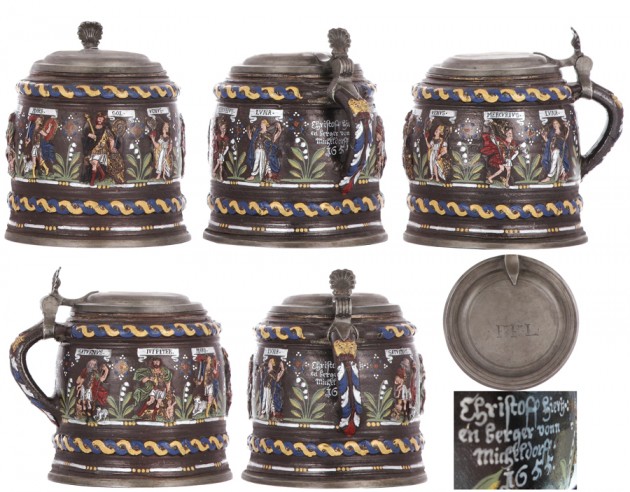
Planet steins – (Creussener Planetenkrug,) Made in Kreussen in the 1600’s. Along the lines of the “Apostles” steins; dark brown glaze, bulky, with multicolored reliefs. Expensive when found. Shown: Stoneware, 7.1 ht., dated 1655, [TSACO]
Planishing — The use of a hammer with a smooth, slightly convex head to remove the marks left on an object by the raising process. This is a finishing, not a shaping, technique.
Plate —A confusing word, used in England and on the Continent when referring to articles made of precious metals = Sterling silver and gold. Used in the United States to mean electro – silverplated articles.
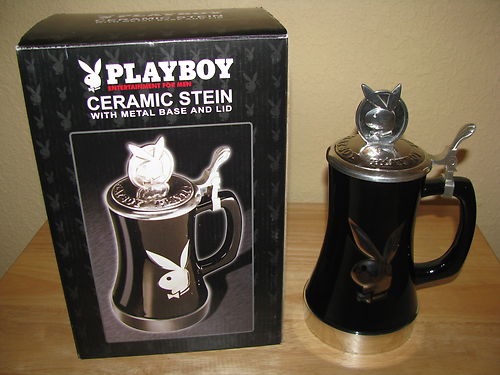
“Playboy” stein – A sign of the early times of the Playboy Empire, when the night clubs were open. A souvenir of spending lots of money looking at the bunnies who were anything but that!!, .(unless you had a 70 foot yacht and million in your hip pocket!)
P.O.G. / POG – “Print Over Glaze.” An applied decal which is then glazed over to protect it. See: PUG for opposite.
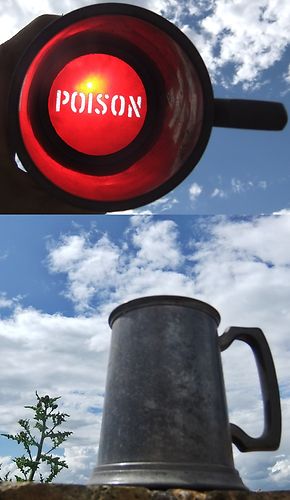
Poison tankard / mug – A newer English pewter joke mug. For use at ones home when the visiting drinker finished off his ale / beer, this is the message he got. Nice friends, hey ?
Pokal (Germ.) – (English: Cup and Cover) – Quite possibly the first type of drinking vessel with a lid. Shown: 12 inch tall ruby stained, cut to clear pokal with engraved fellowship / religious scenes on all the small ruby stained panels. Probably made by Josephinehütte. Ca. 1850 [FWTD]
F or an older example of a nice pokal in pewter, see “Pewter” above.
For more info on these symbols, See Tab this web site: “ Fellowship symbols on ruby cut-to-clear glass drinking vessels.”
http://www.steveonsteins.com/ruby-cut-to-clear-fellowship-symbols-1 AND:
http://www.steveonsteins.com/theresienthal-glass-steins-photo-examples-1-2
Polterabend – The term for a German wedding custom in which on the night before the wedding the guests break porcelain to bring luck to the couple’s marriage. The belief in the effectiveness is expressed by the old adage: “Shards bring luck” (German: Scherben bringen Glück). The expression is derived from a time when the word “shard” referred to the unbroken clay pots of pottery makers, and not just the broken pieces. It was said that a full jar was a lucky thing to have, therefore the expression “shards bring luck”.
The word “Polterabend” comes from German verb poltern (to make a racket) + noun Abend (evening). It’s the common word used to mean a bachelor party in several other European countries.
[edit] Event
The Polterabend normally takes place in front of the house of the bride (or that of her parents), although exceptions are made for space considerations, for example. The couple generally announces the occasion but does not specifically send out individual invitations. Word spreads via word of mouth, and those with a desire to show up may do so. Many couples use this as a way of including people whom they are not able to invite to the wedding itself. Something to eat and/or drink is arranged (either provided for or requested of the guests). Often times guests will bring their gifts to the Polternabend.
The actual high point of the custom is the throwing onto the ground of porcelain that has been brought. However, stoneware, flowerpots or ceramics such as tiles, sinks and toilet bowls are also happily-thrown items. Metal objects such as tin cans and bottle tops are brought along to the festivities. Forbidden are glasses (glass stands for happiness that should not be broken) and especially mirrors (as a broken mirror will bring seven years of bad luck). The couple must thereafter take care of cleaning up the pile of shards. This is supposed to make the couple aware that it will have to work together through difficult conditions and situations in life.
Relatively new is the so-called Polter-wedding. In this case, the wedding is combined with the Polterabend, and the smashing occurs in conjunction with the wedding reception.
The origin of the Polterabend is not precisely known. Some believe the Germanic tribes who threw shards to drive off evil spirits to be the origin. Others believe the heathen ritual of the shattering of clay sacrifice altars after a sacrifice to the gods to be responsible. It is possible that the Polterabend has a psychological motive: suitors who may have wished to have this bride for themselves have the opportunity to “let the steam out” in a socially appropriate manner, so that peace in the village could better be maintained.
[edit] Regions
The Polterabend is most often celebrated on the Friday evening before the church ceremony, even in some regions on the Thursday or Saturday evening before. If the Polterabend occurs on the eve of the wedding, the couple is permitted to leave the fest early (i.e. around midnight), so as to be fresh and without hangover on the next morning – the Polterabend is traditionally celebrated with more gusto and frolicking than the actual wedding festivities.
This is only the case in some parts of Germany. In Bavaria, as well as in Austria and Switzerland, bride and groom get separate bachelor/ette parties rather than a Polterabend.
Some regions additionally celebrate the so-called custom of “Paube”: the Paube can also be celebrated days or weeks before the wedding. On one hand, it is meant as a sort of engagement party; on the other hand, it is often coupled with the housewarming of a new shared dwelling for the couple and expresses the joy of future life together. The Paube is less raucous than the Polterabend. Normally, the father of the bride grills by the Paube. In some areas of Hesse the traditional green sauce from seven herbs is prepared; here the color green and the number seven stand for lucky charms for the couple.
The Polterabend is commonly celebrated in the western parts of Poland – especially in Wielkopolska, Silesia, Kashubia, Kujawy and Kociewie, where significant German cultural influences used to be.
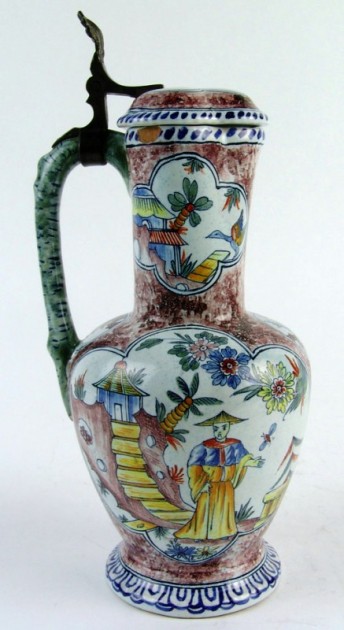
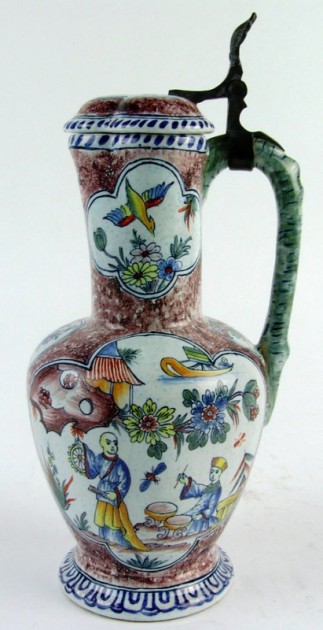
Polycrome – An archaic antiques dealer and auctioneer’s term meaning simply = many colors. Shown ▲: A newer Dutch Delft serving stein done in the 1700’s traditions and advertised as “Polycrome” on eBay in 2012.
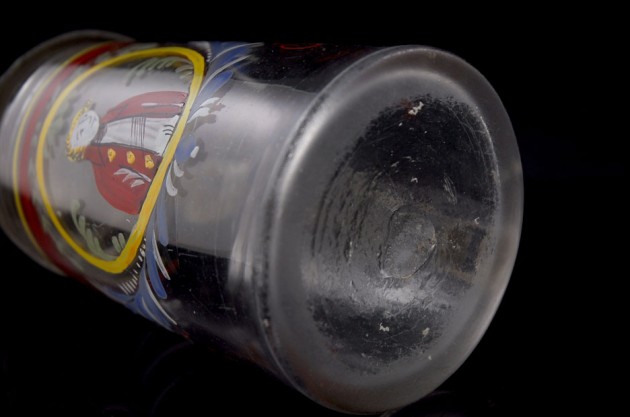
Pontil “mark” – The rough surface on the bottom of a glass stein where the blow pipe was broken off. Some of these are then heat fired and smoothed. A pontil mark “usually “indicates a good old age.
although as with everything they are being reproduced, so look for the wear marks around the bottom of the glass stein!! This “ruff” part of the base may be called a “pontil scar” by strictly glass collectors. Shown above ▲: An enameled 1780’s Bohemian clear glass stein with an unpolished pontil.
Shown below ▼: A ground down pontil mark on a Bohemian “Milk Glass” stein. Circa 1840.
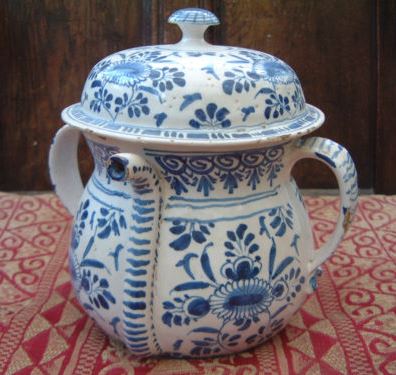
POSSET-POT ENGLISH-DELFT-1721-DELFTWARE WHICJ IS SAME AS FAIENCE/ FAYENCE
Poppelsdorf 1755-19?? – City or town of major fayence stein production. For more info, see: http://www.thepatriotexchange.com/pss/hisfai.htm
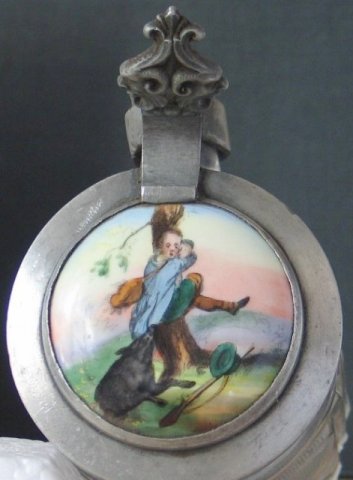
Porcelain insert – The round disk inserted into the pewter lid. All of the older ones are hand painted and some collectors only buy the stein for the displayed scene on the lid. These became popular about 1840 or so, and continue through today. The ones today are mostly decal images and not hand painted like the originals. The originals were seldom signed and were made in a factory production climate.
It hasn’t been proven but I think all the female profiles were the stein owner’s wife, daughter or girl friend, as some of them show “The Lee Sisters” = “Homely” and “Ugly!”, and I further think traveling artists painted them at the lady’s homes.
ALSO SEE: http://www.steveonsteins.com/lid-review-old-and-new-2
A utilitarian and not a very fancy porcelain stein.
.
Porcelain steins – Beer steins made of a glassy white ceramic with some translucency, extreme hardness and a smooth surface. A vitrified, fine white clay, quartz, and feldspar mixture. porcelain is fired at temperatures above 1350°C. to about 1450°C (2650°F). Soft paste porcelain is fired to about 1200°C (2200°F);
Glazed items present a hard, shiny, glass-like surface. Unglazed items have a non-shiny finish known as “biscuit” / “bisque.” The first European porcelain was made by Johann Friedrich Boettger in Dresden in 1708. This “German Porcelain” is made of special formulated clay developed in Saxony. The biggest early porcelain production centers in Germany were Dresden and Meissen. ▼ & ▼ ▼
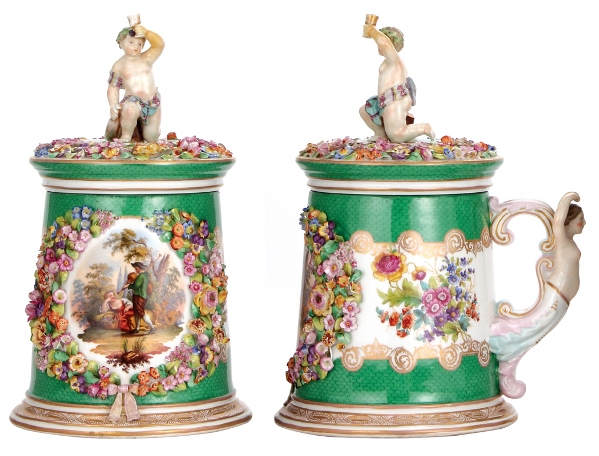
Porcelain,Unmarked Dresden, 16.3 inch ht.[!!] handpainted, figural floral wreath, man playing bagpipe for a woman, with a set-on lid, a drinking putti as the finial, with figural handle. (Not cheap my friends!)
.
There are thousands of varieties of porcelain steins available to the new collector. Some day soon [?] I may do a full page on Porcelain steins. In the mean time here are a few that might be of interest .
RECOMMENDED READING , PLEASE SEE: http://www.thepatriotexchange.com/pss/pottery.htm
and if it is still available on the WWW, this is an interesting little history about Meissen porcelain:
http://www.nytimes.com/2011/12/16/arts/design/a-jewel-box-for-translucent-treasures.html?_r=1&emc=eta1
.
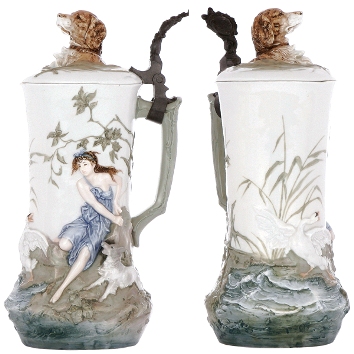
PORCELAIN Called “Pate-sur-pate” —A much better use of the raw material than that shown above. ▲ – 1.0L, 10.5 ht, relief, porcelain lid, very unusual. but it is not, see the prior page for another example. [Maker unknown. [tsaco]
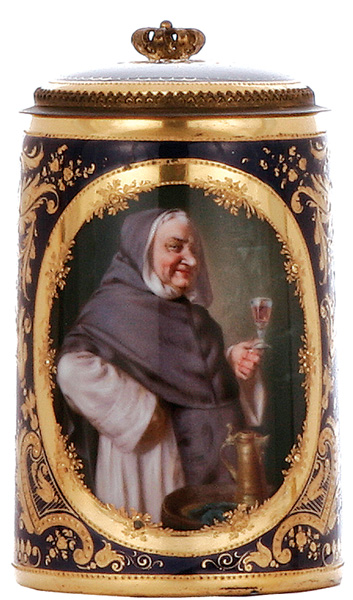
PORCELAIN (Royal Vienna-style) 6.2 in. ht. hand painted-half liter, marked with beehive Edward Grützner design of a monk with a porcelain inlaid lid.
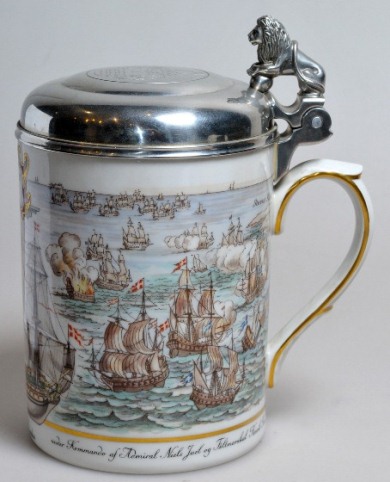
PORCELAIN Royal Copenhagen factory – A 300 year Anniversary Tankard = Sea Battle at Køge Bay in 1677
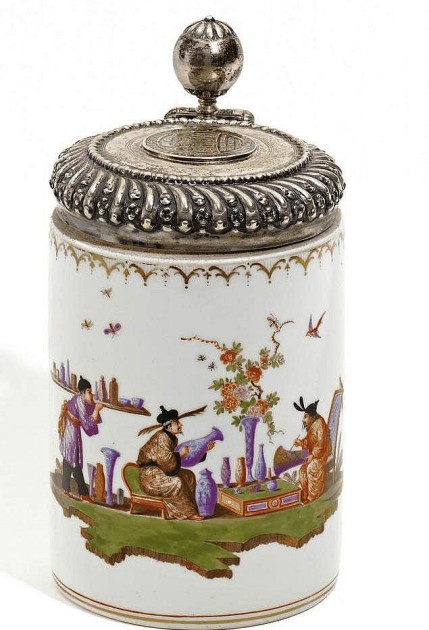
Porcelain – Meissen, Silver lid and medallion.
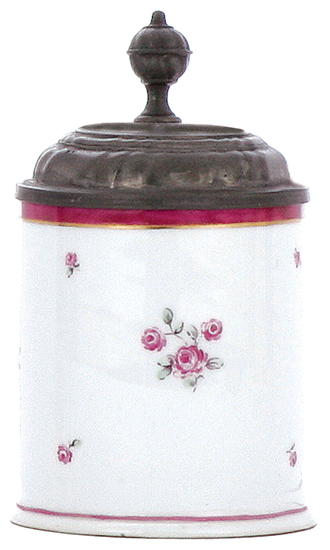
PORCELAIN – Nymphenberg
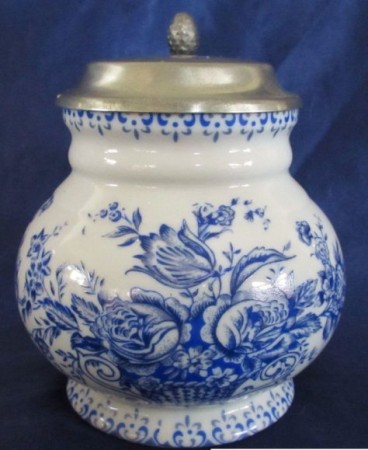
“Porcelana” steins – Newer steins made by firm in Brazil, Not too bad a job.Height is 6.6 inches.
.
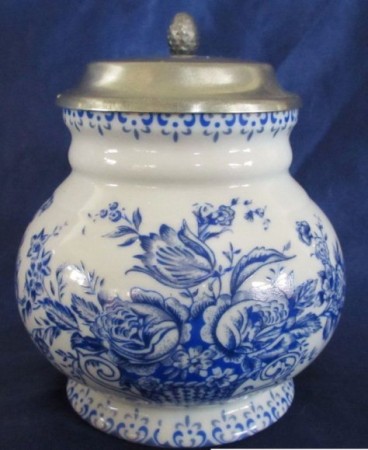
.
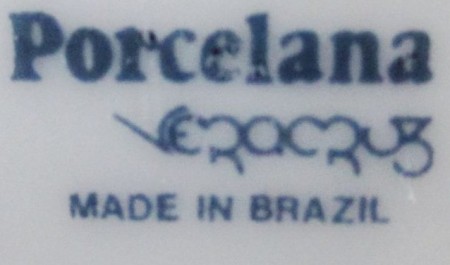
Porcellaine —Another, older name for fayence, which was originally intended as a porcelain substitute.
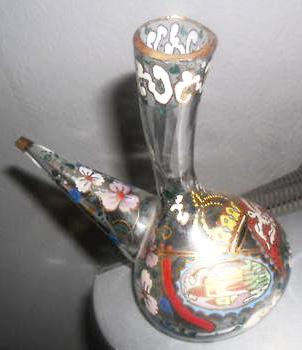
Porron – A Spanish wine drinking vessel, usually individual size, made of many materials, the glass ones being more collectable. [photo comp J.Johnson]
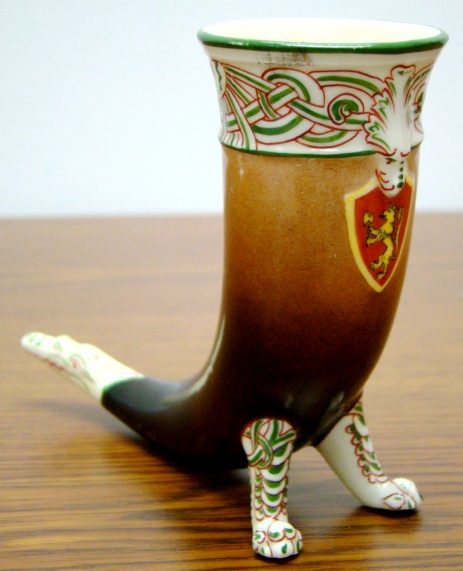
Porsgrund Porcelain, Norway – Porsgrunn porcelain factory was founded in the city of Porsgrunn in 1885, on the south-coast of Norway. For more than 125 years, the factory has produced high-quality china, with inspiration and designs from several well-known artists. Shown ▲: “Trink horn” made of porcelain; date uncertain but early 1900’s I believe.
For more pn “Trink Horn” , see: http://www.steveonsteins.com/in-the-near-future-2
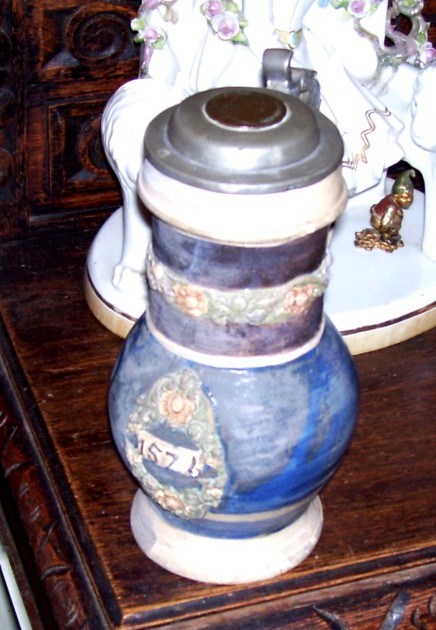
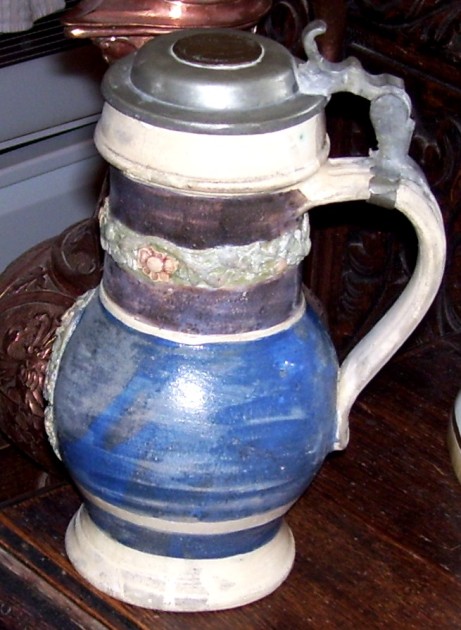
Portuguese Fayence steins –There ids no / so little info on this subject I am not certain this is one . It has a Portuguese coin added to the lid but the 1526’s date on the stein’s body is much earlier than the coin on the lid Best SWAG = the lid was added later. [FWTD]
Portrait mug / stein – Self explanatory. Shown: Hand painting on a one liter (American?) porcelain mug. Circa 1920.
P.O.S.– (Stein collector’s slang) – A “Piece of shit” stein! Some steins should just never have been made, let alone sold! They are a waste of good ceramic or metal molecules. Shown ▲: One of them!!
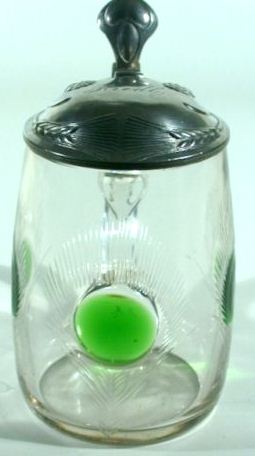
Poschinger glashutte – Called the “Birthplace of Bavarian glass making,” as it is the oldest glassworks in the Bavarian forest; since 1568! Each individual glass is entirely hand made to a very high quality. This firm made about all the drinking vessels one can imagine. Steins, servers. beakers, humpens, pokal, etc. etc.
Shown: An Art Deco .5 liter stein with fire buffed (polished) prunts. The fire smooths them out and they melt into the glass wall, which you can feel from inside.
See history at: http://www.steincenter.com/von-posh.shtm. No sense in me duplicating it.
See also the company’s home web site: http://www.poschinger.de/en/glass-works.html
.
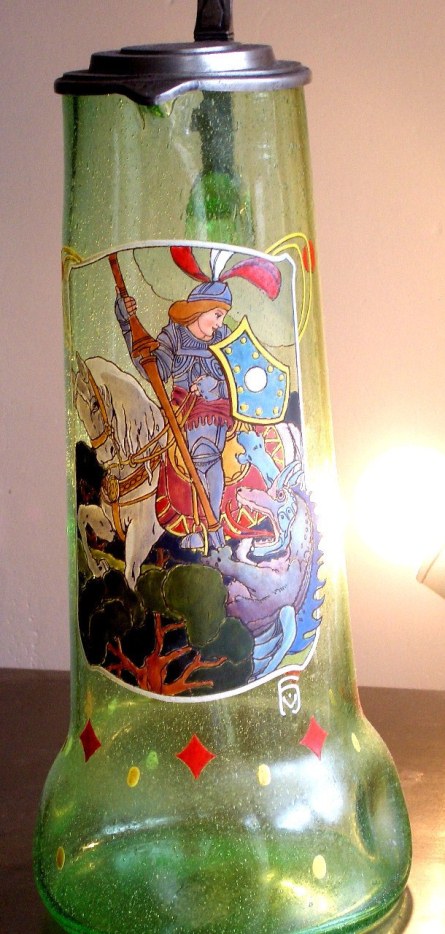
St. George server enameled by Fred. van Hauten. Glass body by Poschinger. 13 inches tall.
Post war military steins (Post WWII) – Also called “American Regimentals” which is another misnomer as these steins were made for every country having troops stationed in Germany (and some from other countries) after WWII. Shown: Photo compliments of “The Stein Center.”One of the same lithophains used in reproduction reservist [regimental] steins.
See: http://www.steveonsteins.com/reservists-regimental-reproductions
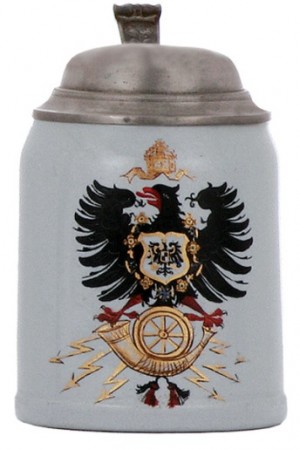
Postal Eagle, German – Old symbol of the German Postal Office. The horn was to announce the arrival of the mail coach or rider. Shown: A V & B Mettlach, No. 1526, hand painted supposedly. Notice the wheel above the horn. [tsaco]
Potsdam 1739-1796 –– City or town of major fayence stein production. For more info, see: http://www.thepatriotexchange.com/pss/hisfai.htm
Pottery beer steins – RECOMMENDED READING, PLEASE SEE: http://www.thepatriotexchange.com/pss/pottery.htm
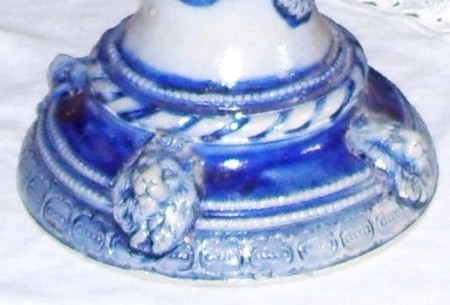
Press mold – The German potters used small press molds to create the pads of decoration that were typically applied to the leather-hard steins, bottles and mugs. etc. Shown▲: Small applied lion’s heads on a Westerwald stoneware jug. An excellent example of the final results of using a press mold.
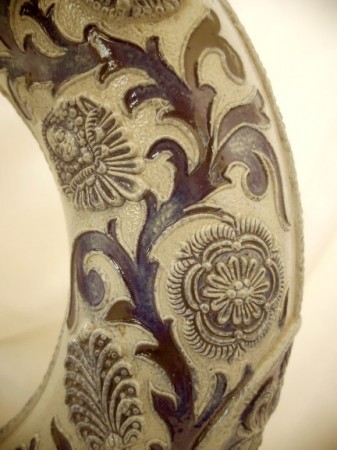
Another example: The rosette, the cupid and shell-flower were all press molded onto a Regensburg [?] ring jug.
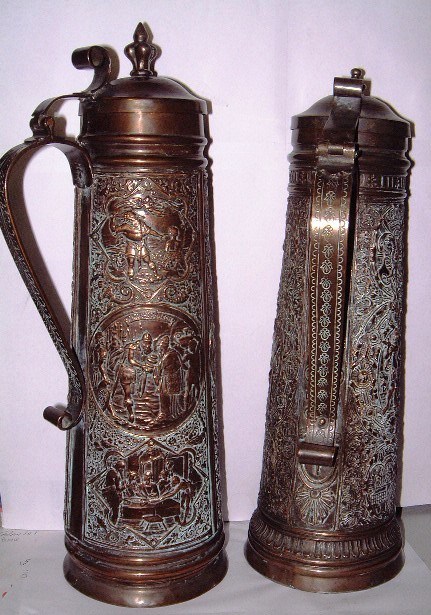
Pressed (metal) / “Stamped” = not! – The mechanical production (since Ca. 1820) of ready-made parts in quantity, complete with their decoration, by the use of hard steel dies cut in reverse to the required pattern. Also called Stamping which is incorrect. Stamped borders, strapwork, etc., used from the 16th century,were hand-hammered from the back, also using hand-cut dies. Shown: A pair of “Pressed “copper beer steins, copies of 1500’s Siegberg stoneware styles.
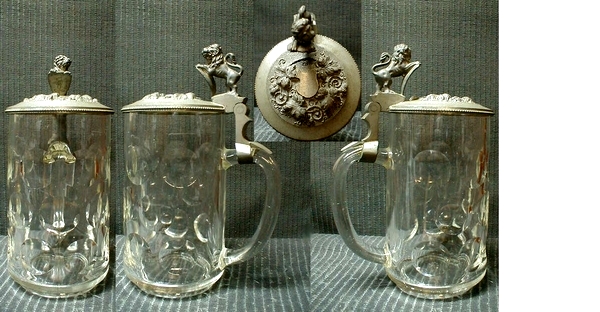
Pressed glass steins – Glass forced into a mold. The cheapest way of making glass steins. First made in any volume shortly after 1900. Look for a seam on the usually squared handle. These are not very well thought of in the stein collecting World, however lots come with really nice porcelain insert lids. Shown ▲: A standard style of pressed glass stein, squared handle and with a very well done pewter lid. [Stein Center]
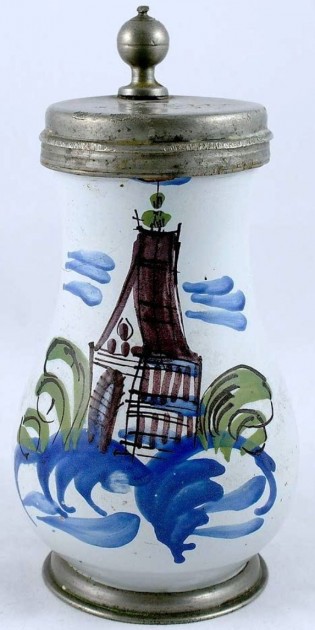
Pre-teen steins – Steins made for adolescent German youths that are bigger than “Kinder Steins” (See: http://www.steveonsteins.com/kinder-steins-page-1-13rd-of-article-text-only) but are not a full half liter in size. These are not cruets, those should have a small pouring spout. Shown ▲: Fayence pre-teen (or lady’s stein) dated 1726! Only 5.5 inches to the top of the lid. [FWTD]
.
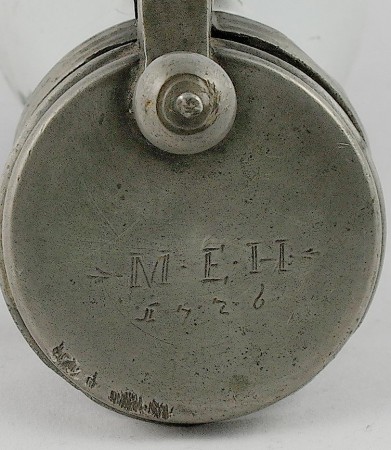
Detail of above.
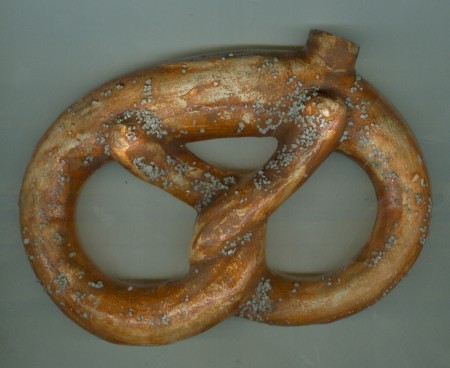
Pretzel flask.– Used for whiskey or schnapps. Shown ▲: 6 inch wide pottery. This has some small crushed rock type substance baked into finish to simulate salt.
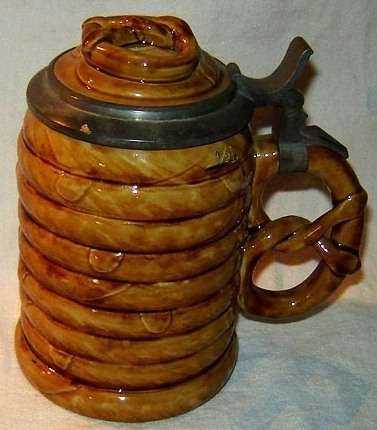
Pretzel steins – As being a bakers was a popular occupation and one thing that goes great with beer is pretzels! There are several versions of pretzel steins to be found on the beer stein market. Shown above ▲: The V & B Mettlach version, .5 liter.
Old wooden staved occupational stein for a pretzel maker. Circa 1860.
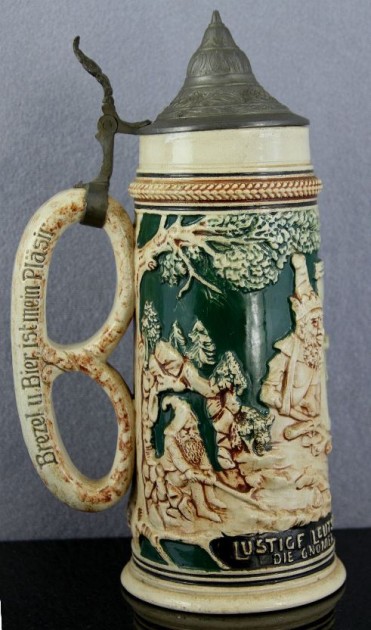
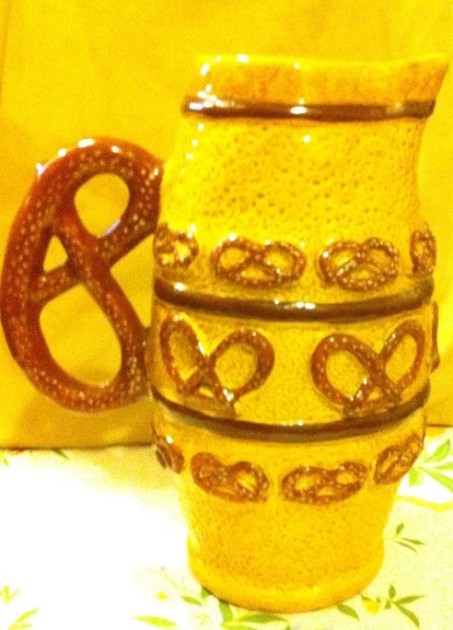
Pretzel on Beer Barrel (somewhat) Pitcher – CALIFORNIA POTTERY~byBrayton Laguna~1940’s
Pricking / Stippling – Tiny dots struck in the surface of a vessel to give detail to an engraved pattern, to render dates, initials and occasionally coats of arms and longer inscriptions.
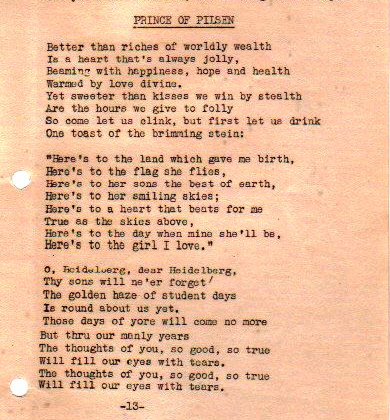
Prince of Pilsen – An old Heidelberg beer drinking song. Shown ▲: Copy of original typed formatted song. Needs to be blown up to be read well.
.
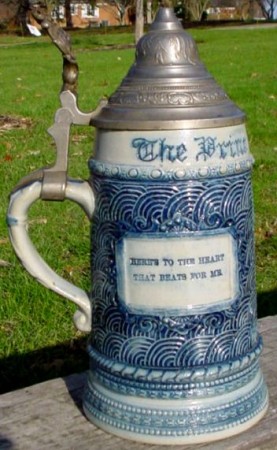
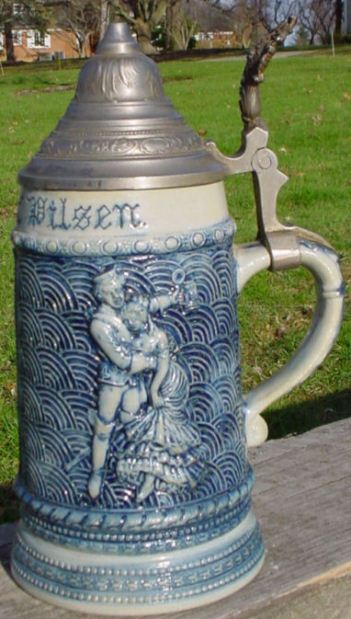
Prince of Pilsen stein- by Whites of Utica. 9 inches tall. This beauty features exquisite detailing that only the Whites Pottery could do in its heyday of making molded stoneware (1890-1907). The stein features a title around the top, “The Prince of Pilsen,” and a circular combed background hosting a dancing couple on one side and a framed saying on the other: “Here’s to the Heart that Beats for Me.”
The stein was made to celebrate the 1903 opening of the Musical Comedy, “The Prince of Pilsen,” which played very successfully in Boston and on Broadway. The plot of the comedy involves three romantic farces which are symbolized by the figures and the saying on the stein.
Print, Old German (on steins) – See article: http://www.beerstein.net/articles/s9412a.htm
Print over glaze — A transfer (decal) decoration fired over the glaze.
Print under glaze, PUG, transfer-printed, or transfer-decorated— The name for a process of decoration that takes hand-painted, silk-screened, or printed decals and transfers those decals to a smooth surface, then fires them in place.
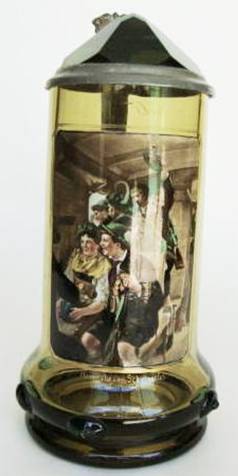
Prism lid – Another gross “misnomer.” Shown: What would be called: “Theresienthal .5 liter stein, blown glass with a cut “Prism lid.” and a Tyrolean scene.
Also see: http://www.steveonsteins.com/beer-stein-dictionary-1
.
It is obvious to me that the first person in stein collecting history (either a stein auctioneer or a member of the SCI Board probably) that coined this word, never took physics in school.This looks nothing like a prism, shown below ▼
![]()
Probe — [1] A mark occasionally found on trial or test pieces.
[2] Probe (Probe zinn) can also be an old mark that refers to the quality contents of pewter.
Prodigal son stein – Originally done as a Saxon pewter tankard by several pewter-smiths in the 1600’s.
The four relief scenes show various aspects of the son’s travels in the bible story. It was heavily reproduced in the late 1800’s, in both pewter and pottery versions. Shown ▲: An all bronze version, which because it is so heavy, has a removable (tin can style) insert for the cup. Very unusual. [FWTD]
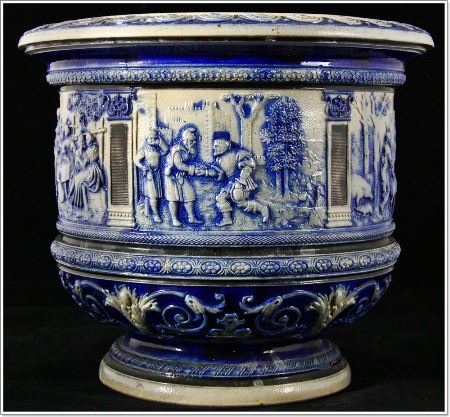
▲A large Westerwald stoneware planter with the biblical scenes as shown on the steins.
Also see tab = “The Prodigal Son’s” beer stein. An interesting bronze version of an older pewter stein: http://www.steveonsteins.com/the-progical-sons-beer-stein-a-rare-bronze-version
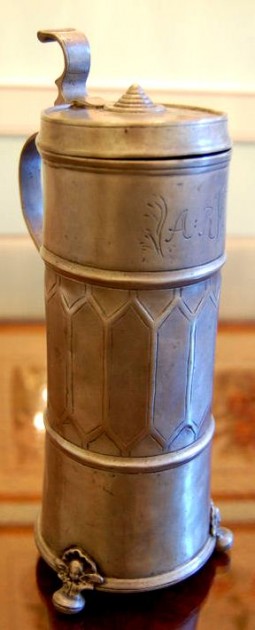
Profile (separator) rings (also called ribs and fillets ) – Those relief rings that mark of different portions of the stein’s body, sometimes for decoration to be added sometimes just to break up the flatness. Shown▲: pewter stein from the 1600’s with two profile rings [FWTD]
“PROSIT” – The quarterly magazine of Stein Collectors International (SCI). The authors of the articles receive no compensation, thereby insuring that the quality of the published “facts” lack credibility and often creative writing style.
There is no requirement to supply references in these articles and there has never been any peer review before publication; not even an attempt since the first issue in 1965! Still there are some morsels of good information in each issue, and probably worth the minimal cost per year, depending if you are a new stein collector or not.
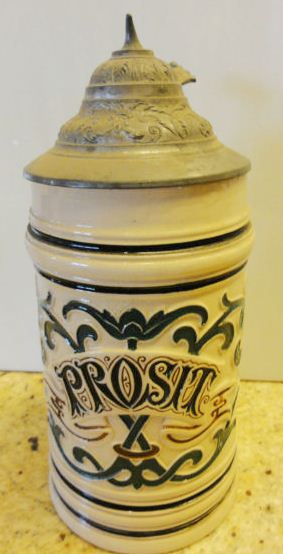
“Prosit!” – The German word. – English = “A toast (to your health.“) Also, “Prost.”
Origin: 1840–50; German Latin: literally, “may it benefit.”
.
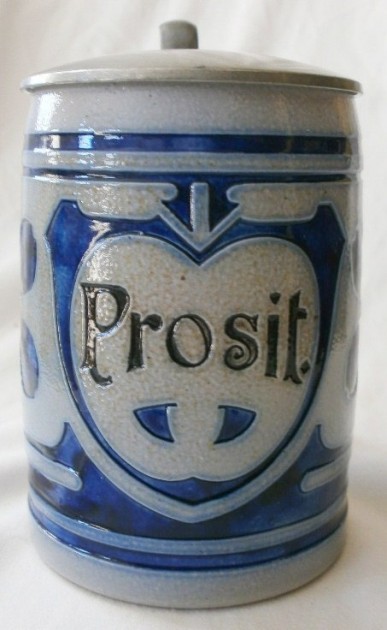
.5 liter Jugendstil beer stein , Karl Görig Design [Ebay’s painterjanie]
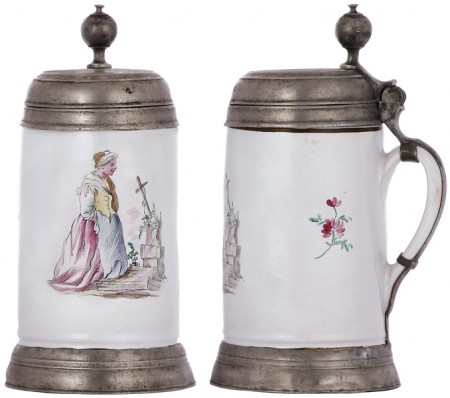
[tsaco]
Proskau fayence steins – 1769-1793 – City or town of major fayence stein production. For more info, see: http://www.thepatriotexchange.com/pss/hisfai.htm
ALSO PLEASE SEE: Bill Hamer’s article this web site: http://www.steveonsteins.com/guest-writers-articles-8-proskau-fayence-beer-steins-by-william-hamer-new-11-30-11.
Prunts (German: Noppen or Nupen [older] ) – Small globs of glass attached to the sides of beakers humpens and other drinking vessels. Originally made to keep the vessel from slipping out of one’s hand while eating greasy food, using one’s hands. There are lots of names for the various styles now: elephant trunk, raspberry, nipple, etc, etc. Shown above: Several flattened prunts applied to a small beaker. Dutch. Circa 1600.
.
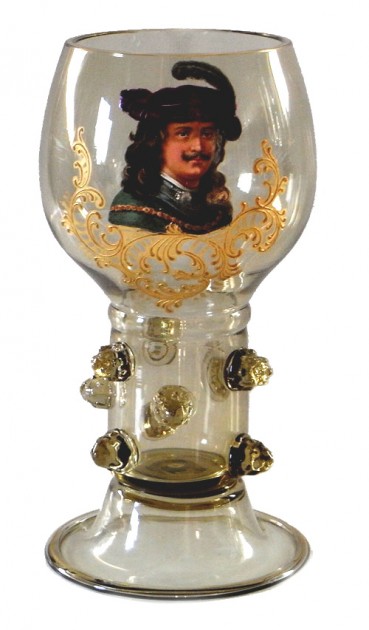
A later day enameled roemer. Ca. 1880 with prunts so big one couldn’t really hold the roemer handily to drink out of it.
Prussian Coat of Arms – A single Eagle with the silver (shown as white mostly) and black quartered shield on it’s breast. This is the eagle that is displayed on the “Imperial German” Eagle’s chest! Shown ▲: Two examples displaying the Prussian arms. Left: A 1 liter pottery relief. Right: A V & B Mettlach . 5 liter version with a silver lid. Both were hand painted. The red and white feathers shown on both the crest and the mantling are indicative of Brandenburg, from where the ruling family originally came from. [BOTH FWTD]
Pseudo Hallmarks — Devices used to suggest English / European marks but never registered. False marks.
P.U.G. / PUG – Not the dog! It means: “Print Under Glaze”, (as opposed to P.O.G. – which is “Print Over Glaze.”) An applied decal which is then glazed over to protect it.
Pull, George English majolica drinking vessel maker , lots of servers
GEORGE PULL – ENGLISH – MAJOLICA .5 LITER STEIN
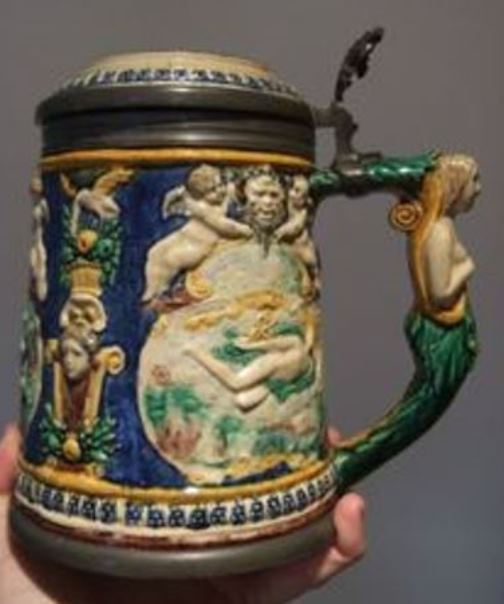
GEORGE PULL – MAJOLICA SERVER
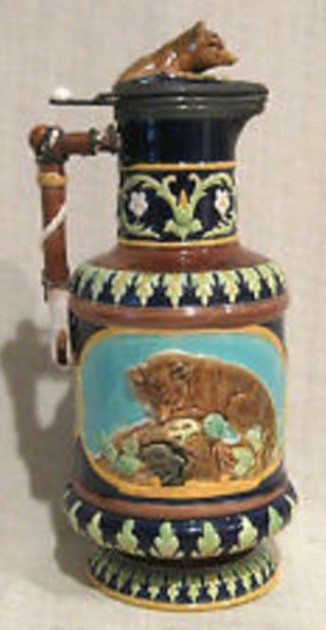
another by Mr.Pull
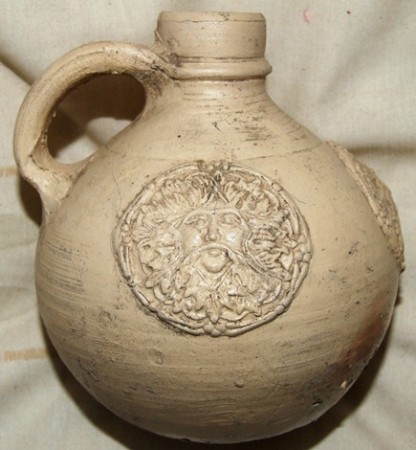
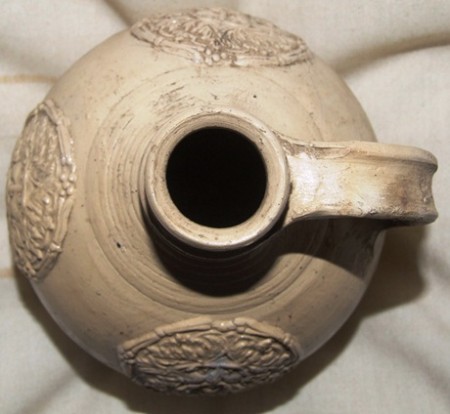
Pulle – German word for “bottle:” not necessarily a glass one either. Shown: A German stoneware “Pulle.” Circa 1560 – 1600, from Cologne (or possibly Siegberg) [D.B.]
Punch – THE DRINK – http://www.npr.org/2010/12/30/132444994/a-vintage-cocktail-that-packs-a-punch
Punchbowls, German – SEE: http://www.steveonsteins.com/german-punsch-punch-bowls-a-pictorial-review-awpd
Puzzle mug / jug – A mug / jug made to trick a novice drinker, or to use at a party, etc It come with holes cut in the body at the top so it would be impossible to drink out of with out getting the “beer” inside all over oneself. These mugs have been made out of every material imaginable and for hundreds of years and in every European country. Shown: A hand painted fayence puzzle jug made in Slovakia, dated 1861.
SEE MORE AT: http://www.steveonsteins.com/in-the-near-future-2-1-2
Pyrographic steins – Wood burnt design (using a burning tool) steins. Very popular around Munich and many were sold as kits in the early 1900’s. Mostly valued for display purposes. Shown top: A small example: A wine stein! Circa 1930-50.
Shown below: An extremely large one from Munich with billed lid.
.
![1 -18 inches - 2l cap [q] ca 1900 [q]](http://www.steveonsteins.com/wp-content/uploads/2011/01/1-18-inches-2l-cap-q-ca-1900-q-237x450.jpg)
[END – SP104 – 64- R5 ]
 Light travels faster than sound. This is why some people appear bright until you hear them speak.
Light travels faster than sound. This is why some people appear bright until you hear them speak.
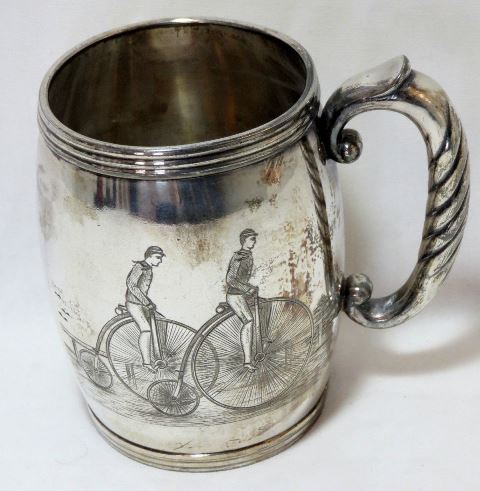
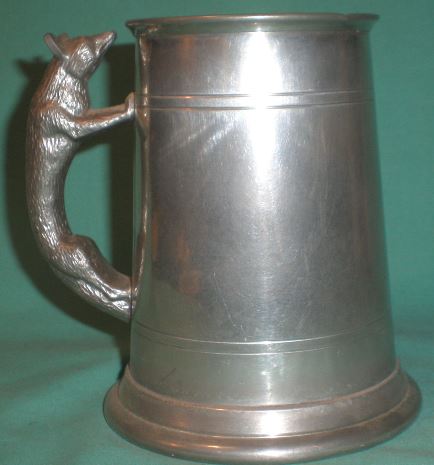

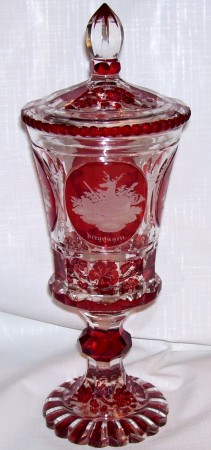
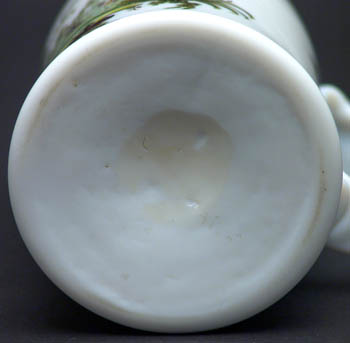

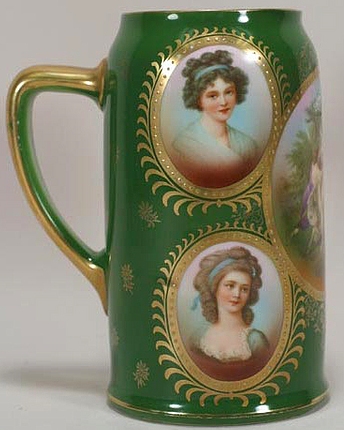
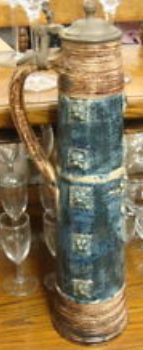
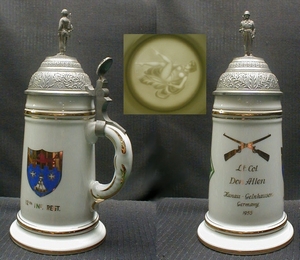
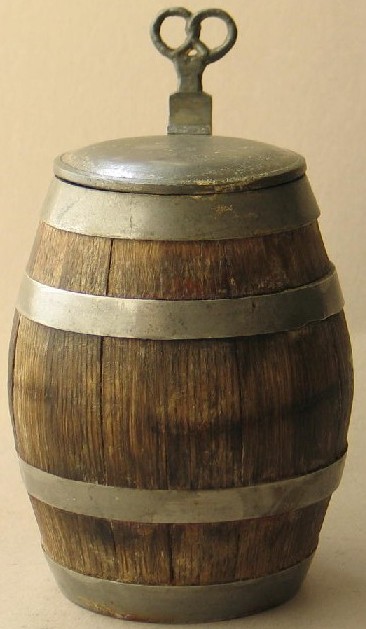
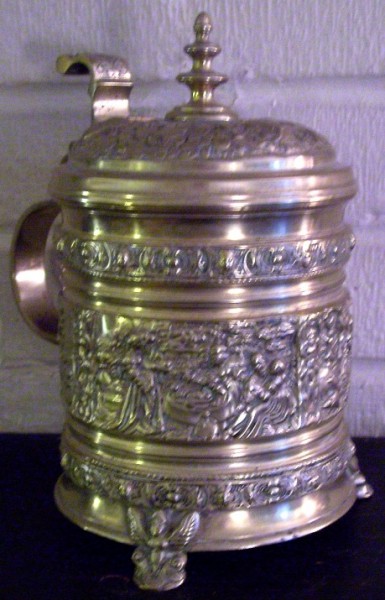
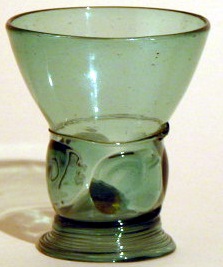
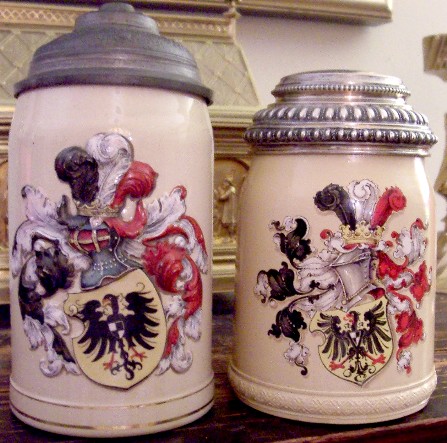
![PUZZLE MUG - SLAVOKIAN - 1851 [2]](http://www.steveonsteins.com/wp-content/uploads/2010/07/PUZZLE-MUG-SLAVOKIAN-1851-2.jpg)
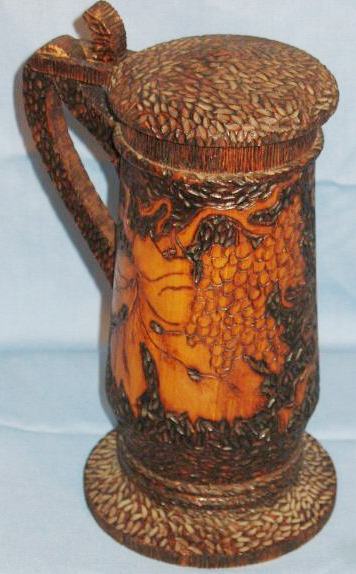
Leave a Reply